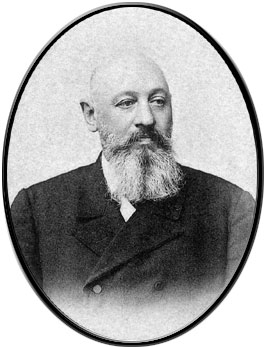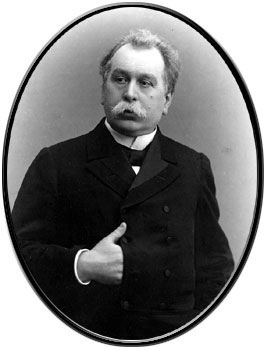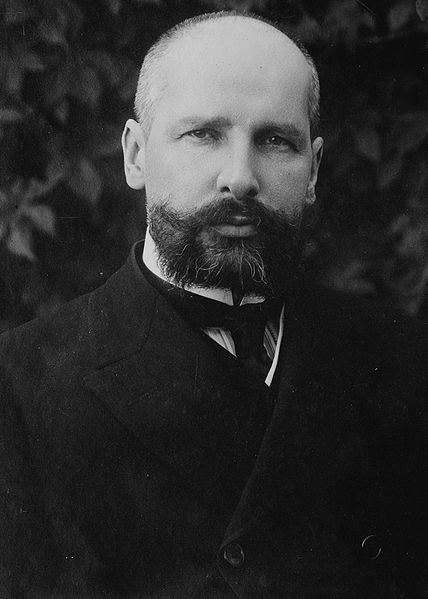<Back to Index>
- Minister of the Interior Dmitry Sergeyevich Sipyagin, 1853
- Minister of the Interior Vyacheslav Konstantinovich von Plehve, 1846
- Minister of the Interior Pyotr Arkadyevich Stolypin, 1862
PAGE SPONSOR

Dmitry Sergeyevich Sipyagin (Дмитрий Сергеевич Сипягин) (March 20, 1853 – April 15, (April 2. O.S.), 1902), was a Russian statesman.
Born in Kiev, Sipyagin graduated from the Judicial Department of Saint Petersburg University in 1876. He served in the MVD as Vice Governor of Kharkov (1886 - 1888), Governor of Courland (1888 - 1891) and Governor of Moscow (1891 - 1893). He became Deputy of the Minister of State Property (1893); Deputy of the Minister of Interior (1894); Executive Director on the petitions of the Imperial Chancellery (1895 - 1899); Director of the Ministry of Interior (1899); Minister of Interior (1900).
He was assassinated in the Mariinsky Palace by Socialist - Revolutionary Stepan Balmashov.

Vyacheslav Konstantinovich von Plehve (Вячесла́в Константи́нович фон Пле́ве), also Pléhve, or Pleve (20 April [O.S. 8 April] 1846 in Meshchovsk, Kaluga Guberniya – 28 July [O.S. 15 July] 1904 in Saint Petersburg) was the director of Imperial Russia's police and later Minister of the Interior.
He was the only son of schoolteacher Konstantin von Plehve and Elizaveta Mikhailovna Shamaev, daughter of a minor landowner. In 1851 Plehve's family moved from Meshchovsk to Warsaw, where his father accepted a job as instructor in a gymnasium.
After studying law at the Moscow University, he became a prosecutor's assistant in 1867 and served in various positions in the Ministry of Justice. He served as assistant prosecutor in the Vladimir circuit court and as prosecutor in Vologda. In 1876 he was appointed assistant prosecutor of the Warsaw Chamber of Justice, and - in 1879 - prosecutor of the Saint Petersburg Chamber of Justice.
In 1881 he investigated the murder of Alexander II and then joined the MVD as a Director of the Department of Police, also in charge of Okhrana. He is credited with the destruction of numerous "People's Will" terrorist groups.
He became a member of the Governing Senate in 1884 and Assistant Minister of Interior in 1885. As Assistant Minister, at first under Count Dmitry Tolstoy and later under his successor, Ivan Durnovo, Plehve had shown definite administrative talent.
Made an Actual Privy Counselor in 1899, he was Finnish Minister Secretary of State from that year until 1904. He supported the abolition of the separate Finnish army in 1901.
In April 1902, following the assassination of Dmitry Sipyagin, he was appointed Minister of the Interior and Chief of Gendarmes. After a brief attempt at conciliation with the zemstvo conservatives failed, he relapsed - disbanding the police - supported labor unions (zubatovshchina).In August 1903 he met with Theodor Herzl in Saint Petersburg, discussing the establishment of Zionist societies in Russia and proposed a Russian government request to the Turks to obtain a charter for Jewish colonization of Palestine.
Plehve was an obvious target for revolutionaries. After he did nothing to prevent a bloody wave of anti - Jewish violence in 1903, the known double agent Evno Azef decided not to inform on the SR plans to kill Plehve. He survived one attack in 1903 and two in 1904 before the Socialist - Revolutionary Combat Group succeeded. On 15 July 1904 a bomb was thrown into Plehve's carriage by Yegor Sazonov, in Saint Petersburg, killing him. He was 58 years old.
Plehve had used his position as Minister of Interior to insist that Hirsh Lekert, the assassin of the governor of Vilna, Victor von Wahl, be tried under wartime law. This virtually guaranteed a death sentence.

Pyotr Arkadyevich Stolypin (Russian: Пётр Арка́дьевич Столы́пин, 14 April [O.S. 2 April] 1862 – September 18 [O.S. September 5] 1911) served as the leader of the third Duma, from 1906 to 1911. His tenure was marked by efforts to counter revolutionary groups and by the implementation of noteworthy agrarian reforms. Stolypin's reforms aimed to stem peasant unrest by creating a class of market oriented smallholding landowners. He is considered one of the last major statesmen of Imperial Russia with clearly defined public policies and the determination to undertake major reforms.
Stolypin was born in Dresden, Saxony, on 14 April 1862. His family was prominent in the Russian aristocracy, and Stolypin was related on his father's side to the poet Mikhail Lermontov. His father was Arkady Dmitrievich Stolypin (1821 – 99), a Russian landowner, descendant of a great noble family, a general in the Russian artillery, and later Commandant of the Kremlin Palace. His mother was Natalia Mikhailovna Stolypina (née Gorchakova; 1827 – 89), the daughter of the Commanding General of the Russian infantry during the Crimean War and later the Governor General of Warsaw Prince Mikhail Dmitrievich Gorchakov.
From 1869, Stolypin spent his childhood years in Kalnaberžė manor (now Kėdainiai district of Lithuania), built by his father, in what remained his favorite residence for the rest of life. In 1876, the Stolypin family moved to Vilnius, where they bought a house, so that their son could study at the local grammar school. He received a good education at Saint Petersburg University and entered government service upon graduating in 1885, joining the Ministry of State Property. Four years later Stolypin was elected marshal of the Kovno Governorate. This public service gave him an inside view of local needs and allowed him to develop administrative skills. He was fascinated by the common lifestyle of the northwestern provinces (especially what is now Lithuania, where his family held estates) and sought to propagate their privately owned, single family farmsteads throughout the Russian Empire.
In 1884, Stolypin married Olga Borisovna Neidhardt, the daughter of a prominent Russian family. They raised five daughters and a son.
In 1902 Stolypin was appointed governor in Grodno, where he was
the youngest person ever appointed to this position. Next, he became
governor of Saratov,
where he became known for suppressing peasant unrest in 1905, and
gained a reputation as the only governor able to keep a firm hold on his
province during this period of widespread revolt. Stolypin was the
first governor to use effective police methods against suspected
troublemakers and some sources suggest that he had a police record on
every adult male in his province. His successes as provincial governor led to Stolypin being appointed interior minister under Ivan Goremykin.
A few months later, Nicholas II appointed Stolypin to replace Goremykin as Prime Minister. Russia in 1906 was plagued by revolutionary unrest and discontent was widespread among the population. With wide support, leftist organizations waged campaigns against the autocracy; throughout Russia, police officials and bureaucrats were being assassinated. To respond to these attacks, Stolypin introduced a new court system that allowed for the arrest and speedy trial of accused offenders. Over three thousand suspects were convicted and executed by these special courts between 1906 and 1909. The gallows were hence referred to as "Stolypin's necktie".
He dissolved the First Duma on July 21 [O.S. July 8] 1906, despite the reluctance of some of its more radical members, in order to facilitate government cooperation. Stolypin introduced land reforms in order to resolve peasant grievances and quell dissent. He also tried to improve the lives of urban laborers and worked towards increasing the power of local governments.
In July 1906 he was elected as Prime Minister. He aimed to create a moderately wealthy class of peasants that would support societal order.
Stolypin changed the nature of the Duma to attempt to make it more willing to pass legislation proposed by the government. After dissolving the Second Duma in June 1907 (Coup of June 1907), he changed the weight of votes more in favor of the nobility and wealthy, reducing the value of lower class votes. This affected the elections to the Third Duma, which returned much more conservative members, more willing to cooperate with the government.
In the spring of 1911, Stolypin proposed a bill, which was not
passed, prompting his resignation. He proposed spreading the system of zemstvo
to the southwestern provinces of Russia. It was originally slated to
pass with a narrow majority, but Stolypin's political opponents had it
defeated. Afterwards he resigned as Prime Minister of the Third Duma.
In September 1911 Stolypin traveled to Kiev despite police warnings that an assassination plot was afoot. He traveled without bodyguards and refused to wear his bullet - proof vest.
On September 14 [O.S. September 1] 1911, while he was attending a performance of Rimsky - Korsakov's The Tale of Tsar Saltan at the Kiev Opera House
in the presence of the Tsar and his two eldest daughters, the Grand
Duchesses Olga and Tatiana, Stolypin was shot twice, once in the arm and
once in the chest, by Dmitri Bogrov (born Mordekhai Gershkovich), who was both a Jewish leftist radical and an agent of the Okhrana.
Stolypin was reported to have coolly risen from his chair, removed his
gloves and unbuttoned his jacket, exposing a blood - soaked waistcoat. He
sank into his chair and shouted "I am happy to die for the Tsar" before
motioning to the Tsar in his imperial box to withdraw to safety. Tsar
Nicholas remained in his position and in one last theatrical gesture
Stolypin blessed him with a sign of the cross. The next morning the
distressed Tsar knelt at Stolypin's hospital bedside and repeated the
words "Forgive me". Stolypin died four days later. Bogrov was hanged
10 days after the assassination; the judicial investigation was halted
by order of Tsar Nicholas II.
This gave rise to suggestions that the assassination was planned not by
leftists, but by conservative monarchists who were afraid of Stolypin's
reforms and his influence on the Tsar. This, however, has never been
proven. Stolypin was buried in the Pechersk Monastery (Lavra) in Kiev, the capital of present day Ukraine).
Opinions about Stolypin's work are divided. In the unruly atmosphere after the Russian Revolution of 1905 some say that he had to suppress violent revolt and anarchy. However, historians disagree over how realistic Stolypin's policies were. The standard view of most scholars in this field has been that he had little real chance of reforming agriculture since the Russian peasantry was so backward and he had so little time to change things. Others, however, have argued that while it is true that the conservatism of most peasants prevented them from embracing progressive change, Stolypin was correct in thinking that he could "wager on the strong" since there was indeed a layer of strong peasant farmers. This argument is based on evidence drawn from tax returns data, which shows that a significant minority of peasants were paying increasingly higher taxes from the 1890s, a sign that their farming was producing higher profits.
There remains doubt whether, even without the interruption of Stolypin's murder and the First World War,
his agricultural policy would have succeeded. The deep conservatism
from the mass of peasants made them slow to respond. In 1914 the strip
system was still widespread, with only around 10% of the land having
been consolidated into farms.
Most peasants were unwilling to leave the security of the commune for
the uncertainty of individual farming. Furthermore, by 1913, the
government's own Ministry of Agriculture had itself begun to lose
confidence in the policy.
After Stolypin's elder brother was killed in a duel, Stolypin challenged his brother’s duelist. As a result, Stolypin was wounded in the right arm, which was almost paralyzed after the incident.
Stolypin's death was allegedly prophesied by Grigori Rasputin, who is reported to have shouted, "Death is after him! Death is driving behind him!" as he ran after the imperial couple in the crowd outside the opera house.
In a 2008 television poll to select "the greatest Russian", Stolypin placed second, behind Alexander Nevsky and followed by Joseph Stalin.
He was a keen taxidermist and had accrued one of the largest collections of animals in the world.